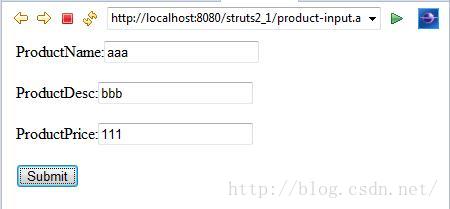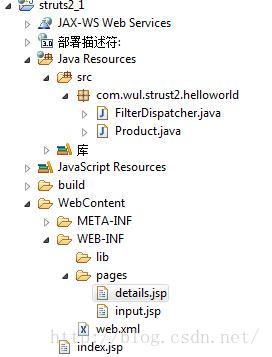struts2_1:strust2的设计模式
先来看看MVC设计模式
实现MVC(Model,View,Controller)模式的应用程序由三大部分构成:
--模型:封装应用程序的数据和业务逻辑:POJO(Plain Old Java Object),一个普通的java类
--视图:实现应用程序的信息显示功能 :jsp
--控制器:接收来自用户的输入,调用模型层,响应对应的视图组建: servlet 和 filter
Struts2的控制器是用Filter实现的
下面是用Filter来做controller的一个小实例
Product.java
package com.wul.strust2.helloworld;
public class Product {
private Integer productId;
private String productName;
private String productDesc;
private double productPrice;
public Product() {
}
public Product(Integer productId, String productName, String productDesc,
double productPrice) {
this.productId = productId;
this.productName = productName;
this.productDesc = productDesc;
this.productPrice = productPrice;
}
public Integer getProductId() {
return productId;
}
public void setProductId(Integer productId) {
this.productId = productId;
}
public String getProductName() {
return productName;
}
public void setProductName(String productName) {
this.productName = productName;
}
public String getProductDesc() {
return productDesc;
}
public void setProductDesc(String productDesc) {
this.productDesc = productDesc;
}
public double getProductPrice() {
return productPrice;
}
public void setProductPrice(double productPrice) {
this.productPrice = productPrice;
}
@Override
public String toString() {
return "Product [productId=" + productId + ", productName="
+ productName + ", productDesc=" + productDesc
+ ", productPrice=" + productPrice + "]";
}
}
index.jsp
<%@ page language="java" contentType="text/html; charset=utf-8"
pageEncoding="utf-8"%>
<!DOCTYPE html PUBLIC "-//W3C//DTD HTML 4.01 Transitional//EN" "http://www.w3.org/TR/html4/loose.dtd">
<html>
<head>
<meta http-equiv="Content-Type" content="text/html; charset=utf-8" />
<title>Hello</title>
</head>
<body>
<a href="product-input.action">Product Input</a>
</body>
</html>
input.jsp
<%@ page language="java" contentType="text/html; charset=utf-8"
pageEncoding="utf-8"%>
<!DOCTYPE html PUBLIC "-//W3C//DTD HTML 4.01 Transitional//EN" "http://www.w3.org/TR/html4/loose.dtd">
<html>
<head>
<meta http-equiv="Content-Type" content="text/html; charset=utf-8" />
<title>Hello</title>
</head>
<body>
<form action="product-save.action" method="post">
ProductName:<input type="text" name="productName"/>
<br><br>
ProductDesc:<input type="text" name="productDesc"/>
<br><br>
ProductPrice:<input type="text" name="productPrice"/>
<br><br>
<input type="submit" value="Submit"/>
</form>
</body>
</html>
details.jsp
<%@ page language="java" contentType="text/html; charset=utf-8"
pageEncoding="utf-8"%>
<!DOCTYPE html PUBLIC "-//W3C//DTD HTML 4.01 Transitional//EN" "http://www.w3.org/TR/html4/loose.dtd">
<html>
<head>
<meta http-equiv="Content-Type" content="text/html; charset=utf-8" />
<title>Hello</title>
</head>
<body>
ProductId: ${requestScope.product.productId }
<br><br>
ProductName: ${requestScope.product.productName }
<br><br>
ProductDesc: ${requestScope.product.productDesc }
<br><br>
ProductPrice: ${requestScope.product.productPrice }
<br><br>
</body>
</html>
FilterDispatcher.java
package com.wul.strust2.helloworld;
import java.io.IOException;
import javax.servlet.Filter;
import javax.servlet.FilterChain;
import javax.servlet.FilterConfig;
import javax.servlet.ServletException;
import javax.servlet.ServletRequest;
import javax.servlet.ServletResponse;
import javax.servlet.annotation.WebFilter;
import javax.servlet.http.HttpServletRequest;
@WebFilter({ "/FilterDispatcher", "*.action" })
public class FilterDispatcher implements Filter {
public void destroy() {}
public void doFilter(ServletRequest request, ServletResponse response, FilterChain chain) throws IOException, ServletException {
//1.获取servletPath
HttpServletRequest req = (HttpServletRequest) request;//注意ServletRequest接口里是没有getServletPath方法的,其是HttpServletRequest子接口里的方法
String servletPath = req.getServletPath();
String path = null;
//2.判断servletPath,若等于"/product-save.action",则转发到
//WEB-INF/pages/input.jsp
if("/product-input.action".equals(servletPath)){
path = "/WEB-INF/pages/input.jsp";
}
//3.若其等于"/product-save.action",则
//1).获取请求参数
if("/product-save.action".equals(servletPath)){
String productName = request.getParameter("productName");
String productDesc = request.getParameter("productDesc");
String productPrice = request.getParameter("productPrice");
//2).把请求信息封装成一个Product对象
Product product = new Product(null, productName, productDesc, Double.parseDouble(productPrice));
//3).执行保存操作
System.out.println("save product"+product.toString());
product.setProductId(1001);// 在这里就不进行保存操作了
//4).把Product对象保存到request中,${param.productName} -> ${requestScope.product.productName}
request.setAttribute("product", product);
path = "/WEB-INF/pages/details.jsp";
}
if(path != null){
request.getRequestDispatcher(path).forward(request, response);
return ;
}
chain.doFilter(request, response);
}
public void init(FilterConfig fConfig) throws ServletException {
}
}


由上面的实例可以明确Filter确实可以用来做controller
使用Filter作为控制器的好处
----使用一个过滤器作为控制器,可以方便的在应用程序里对所有资源(包括静态资源)进行控制访问。
<url-pattern>*.action</url-pattern>
Servlet vs Filter
1.Servlet能做的Filter是否都可以实现?嗯
2.Filter能做的Servlet都可以完成吗?拦截器资源却不是Servlet所擅长的。
Filter中有一个FilterChain,这个API在Servlet中没有
Filter的功能比servlet要强
文章参考:http://edu.51cto.com/course/course_id-960.html
